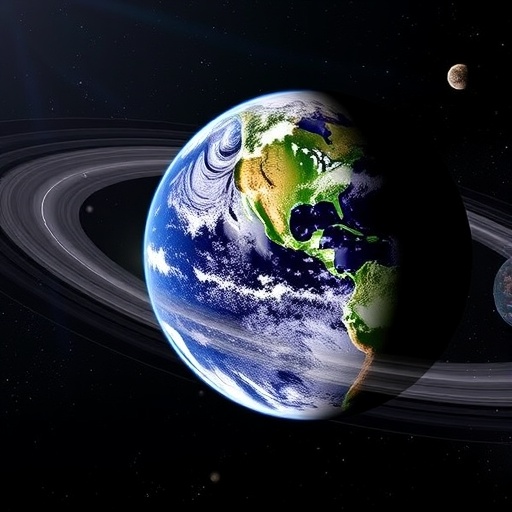In a groundbreaking study, researchers utilizing the Korea Microlensing Telescope Network (KMTNet) have shed new light on the prevalent existence of super-Earth exoplanets across the cosmos. This recent discovery has rewritten previous assumptions about the distribution and occurrence of these planets, indicating that they are not only more abundant than previously estimated but also occupy a range of orbits that challenge our understanding of planetary formation and evolution.
At the heart of this revelation lies the analysis of light anomalies produced by the host stars of newly identified exoplanets. By scrutinizing these anomalies and leveraging a comprehensive dataset from the KMTNet microlensing survey, the international team of scientists, including researchers from China, Korea, and prestigious institutions in the United States, such as Harvard University and the Smithsonian Institution, has unveiled evidence suggesting that super-Earths can reside at significant distances from their parent stars—similar to the positioning of gas giants like Jupiter and Saturn in our own solar system.
The implications of this study are profound. Earlier theories had long established a correlation between planet size and proximity to a star, leading to the belief that smaller planets are predominantly found in tighter orbits. However, Andrew Gould, a co-author of the study and professor emeritus of astronomy at The Ohio State University, articulates a shift in our comprehension of planetary demographics. “We knew there were more small planets than large ones,” he notes, “but this study clearly demonstrates that within this overarching pattern, there can be both excesses and deficits of certain types of planets.”
Super-Earths are characterized by their mass, which falls between that of Earth and Neptune, and their existence raises intriguing questions regarding their formation processes. These planetary bodies often evade detection due to their distant orbits, yet the findings from this study indicate that for every three stars in our galaxy, at least one super-Earth should share a Jupiter-like orbital period. This prevalence points to the possibility that these planetary giants may be far more common than we previously acknowledged.
The methodology underpinning these findings hinges on the principle of gravitational microlensing—a captivating phenomenon arising from the distortion of space-time caused by the mass of celestial objects. When a star with a planet passes directly in front of a more distant star, the intervening mass warps light, creating a temporary amplification in brightness that researchers can detect. This effect can persist anywhere from a few hours to several months, allowing astronomers to illuminate the presence of distant worlds.
In executing this investigative approach, the researchers identified a super-Earth designated OGLE-2016-BLG-0007, which boasts a mass approximately double that of our planet, orbiting at a distance beyond that of Saturn. This substantial finding facilitated the division of known exoplanets into various categories, including a group of super-Earths and Neptune-like planets, contrasting sharply with traditional classifications that emphasized gas giants like Jupiter and Saturn.
The study’s authors employed their results in conjunction with simulations of planet formation. This juxtaposition revealed an intriguing divergence in the mechanisms that may lead to the creation of distinct planetary types. While gas giants have long been understood to form predominantly through runaway gas accretion, the current research highlights the potential role of additional processes, including gravitational instability, in the genesis of these celestial bodies.
Gould emphasizes the importance of refining our understanding of these processes, stating that distinguishing between current theories will necessitate an extensive long-term dataset obtained from ongoing microlensing observations. Richard Pogge, another co-author and a professor of astronomy at Ohio State University, adds that the complexity of microlensing events exponentially increases when searching for planets within them. “Finding a microlensing star event is hard. Finding a microlensing star with a planet is hard-squared,” he explains, highlighting the daunting challenge researchers face.
Despite the challenges inherent to microlensing studies, the KMTNet has empowered scientists to systematically search the cosmos for these rare and informative events. The KMTNet comprises three sophisticated telescopes situated across South Africa, Chile, and Australia—each equipped with custom-built cameras designed and constructed by the Imaging Sciences Laboratory at Ohio State. These telescopes significantly enhance the potential to identify and analyze microlensing events, unraveling the mysteries associated with exoplanets in the process.
The analysis of these rare cosmic occurrences opens a pivotal avenue for planetary system science. Understanding the distribution of various types of exoplanets lays the groundwork for deeper insights into their formation and evolutionary mechanisms. Past research has often focused solely on the characteristics of individual planets, leaving a substantial gap in our knowledge regarding the environmental and systemic conditions that foster their creation.
As the research unfolds, it casts an illuminating light on our collective understanding of the universe’s planetary diversity and the processes that govern them. The findings not only amplify our knowledge of super-Earths but also substantiate the necessity for ongoing exploration technologies that deepen our grasp of celestial phenomena. The collaboration between astronomers and cutting-edge technology is pivotal in translating scientific theories into tangible discoveries, ultimately unearthing the secrets of the universe.
In conclusion, this comprehensive examination of super-Earth exoplanets serves as a vital reminder of the profound complexities present within the fabric of our universe. Just as paleontologists reconstruct the history of life on Earth, astronomers embark on their quest to piece together the dynamic narratives of celestial bodies beyond our world, breathing life into the fabric of theoretical astrophysics with each significant finding.
Subject of Research: Super-Earth exoplanets and their prevalence in the universe
Article Title: Microlensing events indicate that super-Earth exoplanets are common in Jupiter-like orbits
News Publication Date: 24-Apr-2025
Web References: Korea Microlensing Telescope Network
References: Microlensing Effect Overview
Image Credits: Ohio State University
Keywords
Exoplanets, Super-Earths, Microlensing, Astronomical Research, KMTNet, Space-Time Distortion, Planetary Formation, Gas Giants, Astronomy, Cosmic Discoveries.




